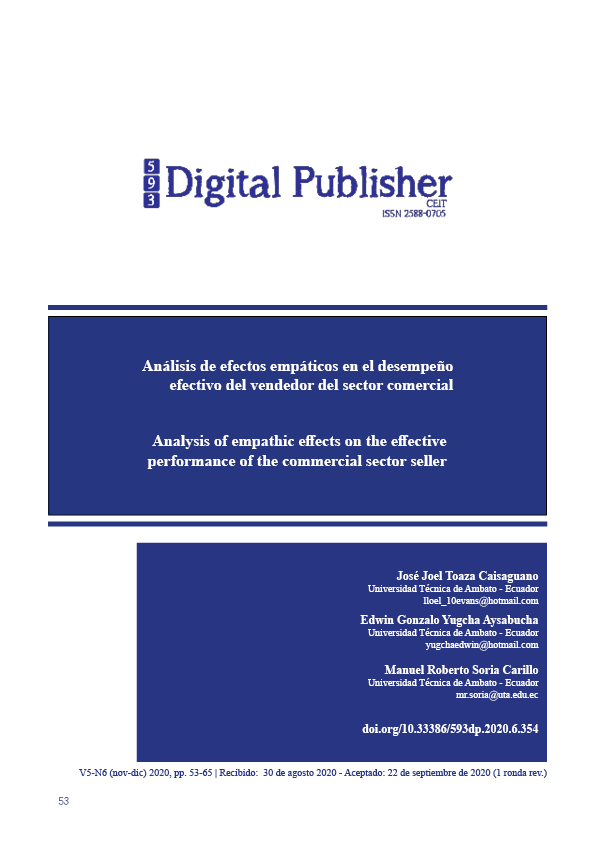Analysis of empathic effects on the effective performance of the commercial sector seller
Main Article Content
Abstract
Emerging competition in today's commercial markets requires increased efforts by business vendors. In many cases, the sales process is affected by the empathetic effects caused by the seller, which has caused the loss of customers. The objective of the investigation was to measure the empathy in the effective performance of the seller of the commercial sector of Ecuador. The qualitative method allowed to propose the construct and evaluation instrument. The quantitative method was applied to measure the degree of empathy of the sellers. The study is correlational, since the relationship of empathic effects on seller performance was validated using the theoretical model and Spearman's Rho statistic. The study sample was sixty (60) vendors from the Ecuadorian commercial sector who provided key information for the development of the research. The main result obtained is that the sellers are at a medium level of empathy. It is concluded that women tend to empathize better in sales. However, they present difficulties in skills competition. However, they have positive attitudes in the sales process.
Downloads
Article Details

This work is licensed under a Creative Commons Attribution-NonCommercial-ShareAlike 4.0 International License.
1. Derechos de autor
Las obras que se publican en 593 Digital Publisher CEIT están sujetas a los siguientes términos:
1.1. 593 Digital Publisher CEIT, conserva los derechos patrimoniales (copyright) de las obras publicadas, favorece y permite la reutilización de las mismas bajo la licencia Licencia Creative Commons 4.0 de Reconocimiento-NoComercial-CompartirIgual 4.0, por lo cual se pueden copiar, usar, difundir, transmitir y exponer públicamente, siempre que:
1.1.a. Se cite la autoría y fuente original de su publicación (revista, editorial, URL).
1.1.b. No se usen para fines comerciales u onerosos.
1.1.c. Se mencione la existencia y especificaciones de esta licencia de uso.
References
Aggarwal, P., Castleberry, S., Ridnour, R., & Shepherd, D. (2015). Salesperson empathy and listening: Impact on relationship outcomes. Journal of Marketing Theory and Practice, 13(3), 16–31. https://doi.org/10.1080/10696679.2005.11658547
Altıntas, F., Kurtulmusoglu, F., Altintas, M., Kaufmann, H., & Alkibay, S. (2017). The mediating effects of adaptive selling and commitment on the relationship between management control and sales performance. EuroMed Journal of Business, 12(2), 221–240. https://doi.org/10.1108/EMJB-12-2016-0037
Anaza, N., Aiefre, E., & Saavedra, J. (2017). Empathy and affect in B2B salesperson performance. Journal of Business and Industrial Marketing.
Ardilla, S., & Castiblanco, A. (2019). Escucha activa y convivencia mucho más que teoría Escucha Activa y convivencia mucho más que teoría.
Carmona, P., Vargas, J., & Rosas, R. (2015). Influencia de la inteligencia emocional en el desempeño laboral. Sapienza Organizacional, 2(3), 53–68.
Cohen, S., & Wheelwright, S. (2004). The Empathy Quotient: An Investigation of adults with asperger syndrome or High Functioning Autism, And Normal sex differences. Journal of Austim and Developmental Disorders, 34(2), 163–175. Retrieved from papers2://publication/uuid/E5EB7E4F-9F8F-4E38-B73F-7384F0190F9B
Espegren, Y., & Panicker, S. (2015). The Study of New Product Selling. Retrieved from http://du.diva-portal.org/smash/get/diva2:828023/FULLTEXT01.pdf
Gomez, M. (2016). Sectores de la economía ecuatoriana desde una perspectiva empresarial: aplicación de la Matriz Boston Consulting Group (BCG). Revista Publicando, 3(8), 266–294.
Howick, J., Moscrop, A., Mebius, A., Fanshawe, T., Lewith, G., Bishop, F., … Onakpoya, I. (2018). Effects of empathic and positive communication in healthcare consultations: a systematic review and meta-analysis. Journal of the Royal Society of Medicine, 111(7), 240–252. https://doi.org/10.1177/0141076818769477
Huayamave, K. (2018). La comunicación empática desde la perspectiva de la educación inclusiva. Actualidades Investigativas En Educación, 18(3), 1–18.
Iacovella, J., Díaz, C., & Richard’s, M. (2015). Relación entre la empatía y los cinco grandes factores de personalidad en una muestra de estudiantes universitarios. Revista Argentina de Ciencias Del Comportamiento ( RACC ), 7(2), 14–21. https://doi.org/10.30882/1852.4206.v7.n2.9038
Loor, H., Ureta, D., & Rodriguez, G. (2018). Analisis del contexto socio-economico, comercial, financiero e internacional de las pymes Ecuatorianas. Revista Cienticfica Ecociencia, 5(4), 1–21.
López, M., Arán, V., & Richaud, M. (2014). Empatía : desde la percepción automática. Avances En Psicología Latinoamericana, 32(1), 37–51. Retrieved from https://www.redalyc.org/pdf/799/79929780004.pdf
López, N., Boluda, I., & Sanden, E. (2012). Antecedentes y efectos del burnout-engagement del vendedor. Cuadernos de Economia y Direccion de La Empresa, 15(3), 154–167. https://doi.org/10.1016/j.cede.2012.02.001
Martin, P., Roman, S., & Fernandez, E. (2011). Influencia de los comportamientos relacionales del vendedor individual sobre la satisfacción, confianza y lealtad del comprador en un contexto de pymes industriales. Investigaciones Europeas de Direccion y Economia de La Empresa, 17(3), 91–109. https://doi.org/10.1016/S1135-2523(12)60122-1
Muñoz, A., & Chavez, L. (2013). La empatía: ¿un concepto unívoco? Katharsis, (16), 123–143. Retrieved from Dialnet-LaEmpatia-5527454 (2).pdf
Muñoz, A., & Hurtado, J. (2011). Asociación entre el funcionamiento familiar y la empatía en adolescentes escolarizados en una institución educativa pública del municipio de medellín adriana.
Muñoz, M. (2015). Conceptualización del neuromarketing : su relación con el mix de marketing y el comportamiento del consumidor. Revista Academia & Negocios, 1(2), 91–104.
Navarro, G., Maluenda, J., & Varas, M. (2016). Diferencias en empatía según sexo y área disciplinar en estudiantes universitarios chilenos de la provincia de Concepción, Chile. Educación, 25(49), 63–82. https://doi.org/10.18800/educacion.201602.004
Otero, V. (2011). La empatía en la educación: estudio de una muestra de alumnos universitarios. Revista Electrónica de Psicología Iztacala, 14(4), 174–190.
Reales, J., & Romero, M. (2016). El coeficiente de empatía en el servicio de ventas: Un estudio de los mecanismos cognitivos del comportamiento empático.
Riess, H. (2017). The Science of Empathy. Journal of Patient Experience, 4(2), 74–77. https://doi.org/10.1177/2374373517699267
Rippé, C., & Dubinsky, A. (2018). Trust me, I’m a physician using sales skills: Enhancing physician–patient communication through the personal selling process. Health Marketing Quarterly, 35(4), 245–265. https://doi.org/10.1080/07359683.2018.1524594
Rodriguez, L. (2019). Empatia Cognitiva-Afectiva: Una revision teorica.
Stros, M., Riha, D., & Möslein, B. (2018). The role of gender in salesperson perception. Marketing Science and Inspirations.
Villa, M. (2013). La inteligencia emocional aplicada en las organizaciones. Revista Questionar, 1(1), 83–91. Retrieved from http://repository.uamerica.edu.co/bitstream/20.500.11839/6316/1/COL0082009-2013-1-GTH.pdf
Wang, E., Tsai, B. K., Chen, T. L., & Chang, S. C. (2012). The influence of emotions displayed and personal selling on customer behaviour intention. Service Industries Journal, 32(3), 353–366. https://doi.org/10.1080/02642069.2010.545392
Yam, L., Jayachandran, B., & Babin, P. (2016). Empathy, nonverbal immediacy, and salesperson performance: the mediating role of adaptive selling behavior. Journal of Business and Industrial Marketing, 31(5).




